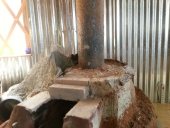Hey Randy;
The majority of builds you read about on Permies are first time builders.
Being excited about their first RMH and not taking the time or having the finances to build a proper stove, they do the best they can.
A common issue I see, is taking "shortcuts" to make building easier or less expensive , almost always those shortcuts come back as a problem later.
Then there are the folks who think they can "improve" on a proven design... they too are rebuilding... to remove those improvements.
Then you have folks who have built a successful RMH but want to upgrade to a larger size or a different design.
I currently have 3 RMHs on line. Two have changed from J-Tubes to Batchboxes, both have been "rebuilt" several times over eleven years as I experiment or fix problems (like firebricks that do not have a high enough temp rating) Each time I make changes I create a better build. Although I have plans to further improve those RMHs, the core units are a solid build using a tension frame rather than mortar to contain the bricks, it is the bells or piped mass that I will modify sometime in the next few years.
My third RMH is a onetime build. A Walker BBQ that I call a black and white oven.
I have no need or desire to make any changes or improvements, it is perfect as is.
Also a "dry" stack build on the core, but due to it's design no tension frame was needed.
https://permies.com/t/164923/rocket-ovens/Build-Black-White-Rocket-Oven
My fourth RMH is being built this summer in our 100 year old cabin.
A 6" "Shorty" Batchbox that I will encase in a brick bell.
The Core is already built and test run out in my shop.
https://permies.com/t/254283/Shorty-Core-Montana-Version-burn
https://permies.com/t/254292/Airframe-Construction-Shorty-Core
This core build is different from my dry stack cores.
A similar tension frame is used but 1/8" Morgan Superwool gasket is placed between every brick surface.
This method will allow the bricks to thermally expand and contract.
My experience is that all mortar will crack over time due to thermal expansion.
My dry stack cores may ultimately crack the firebricks in the core and require a rebuild.
I will mention that my experiments with refractory mortar and 1800F temps inside a core resulted in a rebuild, and the bricks were not reusable without grinding off the old mortar.
I will never build a core with refractory again.
My bells have been and will continue to be built using a clay/sand mortar.
Here is a link to another recent build,
https://permies.com/t/248275/Batch-Rocket-Double-Skin-Bell (see link to the build itself)
Glenn took the time to build properly, he did an outstanding job and he will not be "Rebuilding" anytime soon.
He did use a refractory mortar on the core, and perhaps he may be making a repair or a rebuild, in ten years or so.
The bottom line, follow a proven design, build it carefully with quality materials and you will get proven results.
A true Masonry heater is only fired a few times a day unlike the old wood burners that are lit in october and stay lit 24-7 until spring.
Document your build with photo's and video.
Your grandchildren might need to make repairs after you are not there anymore.

 9
9





 3
3














 13
13




 7
7








 2
2











